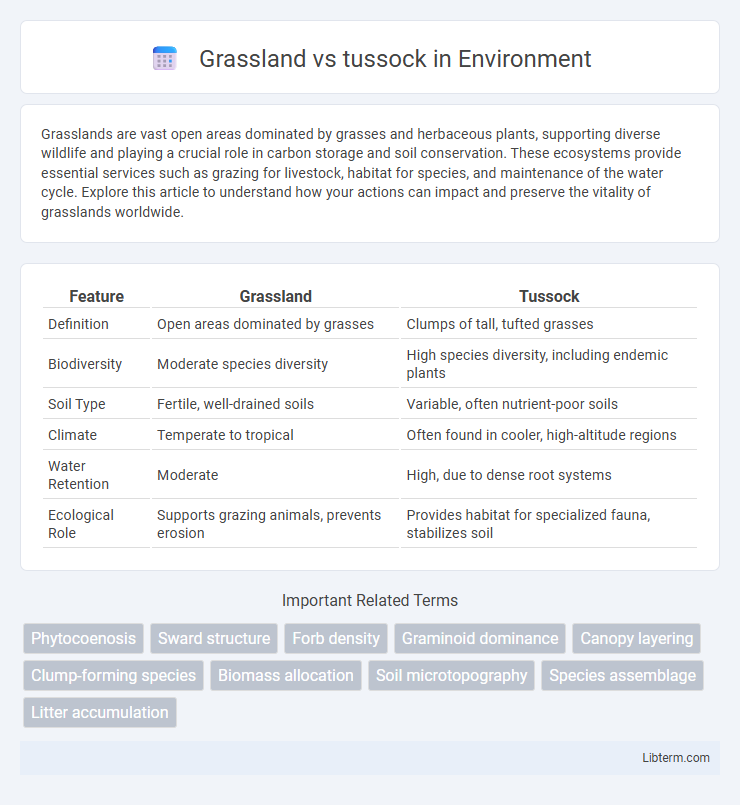Grasslands are vast open areas dominated by grasses and herbaceous plants, supporting diverse wildlife and playing a crucial role in carbon storage and soil conservation. These ecosystems provide essential services such as grazing for livestock, habitat for species, and maintenance of the water cycle. Explore this article to understand how your actions can impact and preserve the vitality of grasslands worldwide.
Table of Comparison
| Feature | Grassland | Tussock |
|---|---|---|
| Definition | Open areas dominated by grasses | Clumps of tall, tufted grasses |
| Biodiversity | Moderate species diversity | High species diversity, including endemic plants |
| Soil Type | Fertile, well-drained soils | Variable, often nutrient-poor soils |
| Climate | Temperate to tropical | Often found in cooler, high-altitude regions |
| Water Retention | Moderate | High, due to dense root systems |
| Ecological Role | Supports grazing animals, prevents erosion | Provides habitat for specialized fauna, stabilizes soil |
Introduction to Grasslands and Tussocks
Grasslands are vast open areas dominated by grasses and herbaceous plants, playing a crucial role in global ecosystems by supporting diverse wildlife and aiding carbon sequestration. Tussocks, characterized by dense clumps of grass or sedge plants, dominate certain grassland types, particularly in cooler or wetter climates, contributing to soil stability and habitat complexity. Understanding the distinctions between general grasslands and tussock formations highlights their ecological functions and importance in maintaining biodiversity and ecosystem health.
Defining Grasslands: Key Characteristics
Grasslands are ecosystems dominated by grasses and herbaceous plants, characterized by their sparse tree coverage and wide-open spaces. They sustain diverse wildlife and support soil fertility through deep-root systems that prevent erosion. While tussocks are clumps of grass within these areas, they represent a structural form rather than a distinct ecosystem, often found in harsher environments within grassland regions.
Understanding Tussocks: Unique Features
Tussocks are dense clumps of grass distinguished by their tufted growth form, often found in grassland ecosystems where they provide critical habitat structure and influence soil moisture retention. Unlike uniform grassland swards, tussocks create microhabitats that support diverse invertebrates and small mammals, enhancing biodiversity. Their deep root systems contribute to soil stabilization and carbon sequestration, making tussock-dominated areas vital for ecological resilience and climate regulation.
Ecological Roles of Grasslands
Grasslands dominate about 20-40% of the Earth's terrestrial area, serving as critical carbon sinks that regulate global climate by storing significant amounts of soil organic carbon. Their diverse plant compositions support a wide array of fauna, including keystone species that influence ecosystem stability and nutrient cycling. Grasslands also prevent soil erosion and maintain hydrological cycles by enhancing water infiltration and retention in contrast to tussock-dominated systems, which typically exhibit patchier vegetation and different soil dynamics.
The Importance of Tussocks in Ecosystems
Tussocks play a crucial role in ecosystems by providing habitat diversity and enhancing soil stability compared to uniform grasslands. Their dense, clump-forming structure creates microhabitats that support a wide range of insects, birds, and small mammals, contributing to biodiversity. Tussocks also improve water retention and nutrient cycling, which promotes ecosystem resilience and productivity.
Differences in Plant Composition
Grasslands predominantly consist of continuous, closely packed grasses such as bluestem, ryegrass, and fescue, providing uniform ground cover ideal for grazing. In contrast, tussock grasslands feature clumps or tufts of grasses like Festuca and Poa species, separated by bare soil or sparse vegetation, creating a patchy structure that supports diverse microhabitats. This fundamental difference in plant composition influences soil erosion rates, biodiversity levels, and grazing patterns within each ecosystem.
Wildlife Diversity: Grasslands vs Tussocks
Grasslands support a higher wildlife diversity due to their extensive open areas and variety of grasses, offering habitat for numerous herbivores, ground-nesting birds, and pollinators. Tussocks provide unique microhabitats with dense clumps of hardy vegetation, attracting specialized species such as small mammals, insects, and certain bird species adapted to more structured environments. Differences in vegetation structure and resource availability directly influence species richness and ecological niches across grassland and tussock ecosystems.
Climate Adaptations in Grasslands and Tussocks
Grasslands and tussocks exhibit distinct climate adaptations driven by their structural and ecological traits; grasslands typically thrive in temperate to semi-arid regions with periodic droughts, relying on deep root systems and rapid regrowth to survive seasonal water shortages. Tussocks, characterized by dense clumps of grasses or sedges, adapt to harsher climates such as alpine or subalpine zones by minimizing exposure to cold and wind, enhancing moisture retention and thermal insulation. These adaptive strategies optimize water use efficiency and temperature regulation, ensuring resilience in diverse climatic conditions.
Human Impact on Grasslands and Tussocks
Human activities such as agriculture, urban development, and livestock grazing have significantly altered grassland and tussock ecosystems, leading to habitat fragmentation and soil degradation. Overgrazing in tussock regions accelerates erosion and reduces biodiversity, while conversion of grasslands for crop production diminishes native plant species and disrupts carbon sequestration processes. Effective management and restoration efforts are essential to mitigate these impacts and preserve the ecological functions of both grasslands and tussocks.
Conservation Strategies for Both Habitats
Conservation strategies for grasslands emphasize controlled grazing, prescribed burns, and invasive species management to maintain plant diversity and soil health. In tussock habitats, protecting native tussock grasses involves limiting land conversion, promoting natural regeneration, and monitoring grazing intensity to preserve ecosystem structure. Both habitats benefit from habitat fragmentation reduction and community-based stewardship programs supporting long-term ecological resilience.
Grassland Infographic

 libterm.com
libterm.com